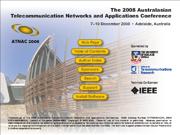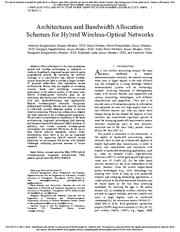A copy of this work was available on the public web and has been preserved in the Wayback Machine. The capture dates from 2017; you can also visit the original URL.
The file type is application/pdf.
Filters
A More Realistic Thinning Scheme for Call Admission Control in Multimedia Wireless Networks
2008
IEEE transactions on computers
A call admission control scheme named thinning scheme, which smoothly throttles the admission rates of calls according to their priorities and aims to provide multiple prioritized traffic with a desired ...
Index Terms-Call admission control (CAC), multimedia, blocking probability, quality of service (QoS), wireless networks, multidimensional Markov birth-death process. Ç . X. Wang and P. ...
CONCLUSIONS In this paper, the thinning scheme was investigated under more general and realistic conditions that are typical in multimedia wireless networks. ...
doi:10.1109/tc.2008.29
fatcat:73reiq2ovvco7nuhhsblk6sxju
Call admission control schemes and performance analysis in wireless mobile networks
2002
IEEE Transactions on Vehicular Technology
Call admission control (CAC) plays a significant role in providing the desired quality of service in wireless networks. Many CAC schemes have been proposed. ...
In this paper, we reexamine some of the analytical results for call blocking probabilities for some call admission control schemes under more general assumptions and provide some easier-to-compute approximate ...
ACKNOWLEDGMENT The authors would like to express their gratitude to the reviewers for their comments, which greatly enhanced the quality of this paper. ...
doi:10.1109/25.994812
fatcat:6ukdzjpezbbhbfcvcqe3t6ong4
Call admission control in mobile cellular networks: a comprehensive survey
2006
Wireless Communications and Mobile Computing
Call admission control is a key element in the provision of guaranteed quality of service in wireless networks. ...
This article provides a survey of admission control schemes for cellular networks and the research in this area. ...
Call admission control (CAC) is a fundamental mechanism used for QoS provisioning in a network. ...
doi:10.1002/wcm.246
fatcat:vooc2ienavadvkbscobragwera
MRTP: a multiflow real-time transport protocol for ad hoc networks
2006
IEEE transactions on multimedia
In this paper, we present a new protocol to facilitate multipath transport of real-time multimedia data. ...
in underlying networks. ...
., for providing the MDMC codec, and the Wireless Communications Technologies Group of the National Institute of Standards and Technology for making the OPNET DSR model available in the public domain. ...
doi:10.1109/tmm.2005.864347
fatcat:fwmggpikdrdmvblk5ye2pon6zy
MRTP: a multiflow realtime transport protocol for ad hoc networks
2003
2003 IEEE 58th Vehicular Technology Conference. VTC 2003-Fall (IEEE Cat. No.03CH37484)
In this paper, we present a new protocol to facilitate multipath transport of real-time multimedia data. ...
in underlying networks. ...
., for providing the MDMC codec, and the Wireless Communications Technologies Group of the National Institute of Standards and Technology for making the OPNET DSR model available in the public domain. ...
doi:10.1109/vetecf.2003.1286033
fatcat:raikt23uofdspmrfscrub73yka
Instant Handoffs for Wireless Infrastructure Meshed Networks
2008
2008 Australasian Telecommunication Networks and Applications Conference
A number of call admission control models have been proposed in literature to reduce the preemption rate of ongoing IR calls. ...
We propose a self-restraining admission control mechanism that works by monitoring the congestion level of the network in the adhoc WLAN. ...
doi:10.1109/atnac.2008.4783338
fatcat:5vdigbtf5nfo7ifyeepevnth54
Handoff prioritization and decision schemes in wireless cellular networks: a survey
2009
IEEE Communications Surveys and Tutorials
Handoff is a key element in wireless cellular networks in order to provide Quality of Service (QoS) to the users and to support users' mobility. ...
From the user's point of view, the service of a handoff request is more important, as the forced termination of an ongoing call is more annoying than the blocking of new calls. ...
For multimedia wireless networks, the dynamic priority queueing is achieved by the Signal Strength for Multimedia Communications Scheme (SSMCS) proposed by Chang and Leu [61] . ...
doi:10.1109/surv.2009.090405
fatcat:gkwjqwcrwfd4fblc3p4wivlb7i
Infotainment and road safety service support in vehicular networking: From a communication perspective
2011
Mechanical systems and signal processing
radio resource management strategies are required, including capacity enhancement, interference control, call admission control (CAC), bandwidth reservation, packet loss/delay reduction, medium access ...
Via wireless communication links, each vehicle communicates with nearby vehicles in a highly dynamic ad hoc networking environment. ...
Call/vehicle admission control In wireless networks with limited radio resources, there is a natural tradeoff among different network design objectives such as increasing throughput, minimizing packet ...
doi:10.1016/j.ymssp.2010.11.009
fatcat:u2pqpbkiozcflnwllplzu5sz7i
Dynamic Resource Management for Mobile Services
[chapter]
2003
Lecture Notes in Computer Science
They also have to be designed in a way which accounts for the relatively higher cost of wireless links with respect to wired ones. ...
The abovementioned requirements call for effective resource management solutions. ...
In order to carry out simulations under realistic network conditions, the algorithm has been implemented over the JavaSim network simulation which provides the underlying support for wired and wireless ...
doi:10.1007/978-3-540-39646-8_15
fatcat:n57bhuyojzeofkkwxpy7btqlw4
Ubiquitous Computing for Remote Cardiac Patient Monitoring: A Survey
2008
International Journal of Telemedicine and Applications
New wireless technologies, such as wireless LAN and sensor networks, for telecardiology purposes give new possibilities for monitoring vital parameters with wearable biomedical sensors, and give patients ...
It will also discuss the current promising hardware/software platforms for wireless cardiac monitoring. The design methodology and challenges are provided for realistic implementation. ...
(iii) Lack of support for network-specific congestion control schemes. ...
doi:10.1155/2008/459185
pmid:18604301
pmcid:PMC2442250
fatcat:tffvd37gdjfudou5vxkdbpgf54
Autonomous QoS Management and Policing in Unmanaged Local Area Networks
2015
Journal of Computer Networks and Communications
We present a new QoS Signalling Protocol, policing and admission control algorithms, and a new lightweight statistical bandwidth prediction algorithm for autonomous resource management in LANs. ...
In this paper, we present the research work on a novel autonomous system for hybrid QoS in local area networks, called QoSiLAN, which does not rely on network infrastructure support but on host cooperation ...
In this solution to QoS for multimedia applications in LANs, also a central management entity, called the Global Resource Manager (GRM), is used as resource coordinator. ...
doi:10.1155/2015/790375
fatcat:m376v3qhdnf4jabaooxjx6432m
Architectures and Bandwidth Allocation Schemes for Hybrid Wireless-Optical Networks
2015
IEEE Communications Surveys and Tutorials
By extending the network coverage in a cost-efficient way, hybrid wirelessoptical networks are able to enclose a larger number of potential subscribers than standalone access architectures. ...
In addition, new trends towards wireless-optical convergence are presented. ...
The suggested AC policy in [90] is called integrated optical wireless admission control (IOW-AC) and runs at the ONUs. ...
doi:10.1109/comst.2014.2356640
fatcat:ezkbm7rbincmzhv54764odjncy
Quality of Real-Time Streaming in Wireless Cellular Networks - Stochastic Modeling and Analysis
[article]
2014
arXiv
pre-print
We present a new stochastic service model with capacity sharing and interruptions, appropriate for the evaluation of the quality of real-time streaming (RTS), like e.g. mobile TV, in wireless cellular ...
Our results can be used for the evaluation of the quality of RTS in LTE networks and dimensioning of these networks. ...
Lin, “Analysis of a hybrid cutoff priority scheme for
multiple classes of traffic in multimedia wireless networks,” Wireless Networks, vol. 4,
no. 4, pp. 279–290, 1998.
[17] S. Wu, K. M. ...
arXiv:1304.5034v3
fatcat:mtataaebtbbphggc2ml44zox2m
Measuring Key Quality Indicators in Cloud Gaming: Framework and Assessment Over Wireless Networks
2021
Sensors
This allows a user's thin client systems with much more limited capabilities to offer a comparable experience with traditional local and online gaming but using reduced hardware requirements. ...
Hence, the future lines for Cloud Gaming QoE-based (Quality of Experience) optimization are established, this way being of configuration, a trendy paradigm in the new-generation networks, such as 4G and ...
Several experiments demonstrated that a 100-ms delay is the maximum admissible value for a gaming session. ...
doi:10.3390/s21041387
pmid:33671141
fatcat:zzkjespeobhcvoor5jlrswvvwe
Broadband wireless access and future communication networks
2001
Proceedings of the IEEE
This paper presents a vision for wireless communication systems beyond the third generation, which comprises a combination of several optimized access systems on a common IP-based medium-access and core ...
network platform. ...
This includes dynamic radio channel allocation, power control techniques, admission-and load control strategies, congestion control, handover strategies, and resource scheduling. ...
doi:10.1109/5.904506
fatcat:xlrctv2jajdrlbzfdpkbuijyry
« Previous
Showing results 1 — 15 out of 222 results














